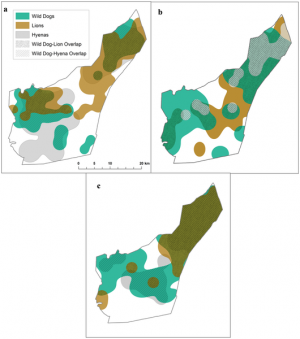June 11, 2014 report
African wild dogs adapt use of space to co-exist with lions and hyenas

(Phys.org) —African wild dogs share their habitat with other, larger carnivores such as lions and spotted hyenas. In a recent paper, published in PLOS one, it was found that African wild dogs adapt their use of space to avoid some larger carnivores. This allows wild dogs to co-exist with lions and hyenas, provided there is enough space to do so.
Carnivore competition
We mostly think of large carnivores being in competition with the prey they hunt and eat. But recently there has more recognition of the conflicts that occur between different carnivore species. African wild dogs, lions and spotted hyenas are just three of many carnivores that inhabit the Hluhluwe–iMfolozi National Park in South Africa. The park is set over about 96,000 hectares, about the size of a small county.
The three carnivores have similar diets; they feed on a range of prey including gazelles and other antelopes. Because they have such similar tastes, the three carnivores have to compete with each other to eat. African wild dogs are smaller than lions and hyenas and usually come off worst in conflicts.
Given the lion's size, it is not surprising that they pose the biggest threat to wild dogs during conflicts. In fact, one of the biggest causes of African wild dog mortality is predation by lions. Spotted hyenas also pose a risk, but they do not kill wild dogs. Instead hyenas are known for stealing freshly killed carcasses from wild dog packs. All conflicts of this kind are of course costly for wild dogs, but it is agreed that lions are a far larger threat to wild dogs than hyenas.
Avoiding danger
Keeping this in mind, Professor Darnell of Humboldt State University, Virginia, and her colleagues from the Smithsonian Conservation Biology Institute, California, collaborated with researchers in South Africa based at the University of KwaZulu-Natal and the University of Pretoria. Their aim was to find out how African wild dogs managed to co-exist with larger carnivores.
"We were very interested to see how wild dogs moved in space relative to their larger competitors, lions and hyenas. Did wild dogs avoid these other carnivores? How did they manage to share space?" Said Dr Gunther, a lead researcher at the Smithsonian Conservation Biology Institute, California.
They tested the idea that wild dogs would avoid other carnivores, and the risks which they pose. It was predicted that dogs would avoid lions more strongly than hyenas, as lions pose more of a threat.
They formed this hypothesis based on examples of avoidance from other carnivore communities. For example, in Nepal it was found that leopards avoided areas with high tiger densities. Another study found that small brown hyenas avoided bigger spotted hyenas because of competition over food.
Darnell and her team completed their research in Hluhluwe–iMfolozi National Park where the movements of six packs of dogs, 12 lion prides and a clan of hyenas where tracked over about two years. Carnivore location, activity and behaviour was recorded every week. This was normally done during either sunset or sunrise, when carnivores are most active.
"Subjects were nearly always observed in person. Wild dogs and lions were located both via radio telemetry and opportunistically. Spotted hyenas were observed mostly opportunistically," said Gunther.
By doing this, the research team were able to define the areas over which each carnivore roamed. They were also able to identify the times during which each carnivore displayed activity. This allowed the researchers to assess both spatial and temporal aspects of avoidance.
It was found that African wild dogs spent the majority of their time in areas that were free of lions. For instance, wild dogs consistently located their dens in areas of low lion density. But given the relatively small size of the national park, sometimes spatial avoidance was not possible. In these situations wild dogs avoided the lions by emerging from their dens to hunt at times when the lions were not active.
Defending kills
But wild dogs did not avoid spotted hyenas, either spatially or temporally. The lack of avoidance shown by the wild dogs to hyenas was probably due to the relatively large pack size of the dogs in Hluhluwe–iMfolozi National Park. This would be an advantage during a conflict and may allow the dogs to defend their kills adequately from any scavenging hyenas.
Gunther concluded by saying: "we cautiously suggest that wild dogs can co-exist with lions and hyenas, but they need enough space to do so".
More information: Darnell AM, Graf JA, Somers MJ, Slotow R, Szykman Gunther M (2014) Space Use of African Wild Dogs in Relation to Other Large Carnivores. PLoS ONE 9(6): e98846. DOI: 10.1371/journal.pone.0098846
Abstract
Interaction among species through competition is a principle process structuring ecological communities, affecting behavior, distribution, and ultimately the population dynamics of species. High competition among large African carnivores, associated with extensive diet overlap, manifests in interactions between subordinate African wild dogs (Lycaon pictus) and dominant lions (Panthera leo) and spotted hyenas (Crocuta crocuta). Using locations of large carnivores in Hluhluwe-iMfolozi Park, South Africa, we found different responses from wild dogs to their two main competitors. Wild dogs avoided lions, particularly during denning, through a combination of spatial and temporal avoidance. However, wild dogs did not exhibit spatial or temporal avoidance of spotted hyenas, likely because wild dog pack sizes were large enough to adequately defend their kills. Understanding that larger carnivores affect the movements and space use of other carnivores is important for managing current small and fragmented carnivore populations, especially as reintroductions and translocations are essential tools used for the survival of endangered species, as with African wild dogs.
Journal information: PLoS ONE
© 2014 Phys.org




















